As an experienced, down-to-earth plumber at Ferguson’s Plumbing, I’ve gathered some practical advice on creating pet-friendly spaces in your home, specifically focusing on the kitchen area.
Whether you’re a seasoned pet owner or just starting your journey with a four-legged friend, here are some essential features for pet-friendly kitchen design and living spaces:
- Strategic Kitchen Design: Planning your space for companionship is vital to create a mutually comfortable environment for you and your pet.
- Pet-Safe Materials and Surfaces: Make sure the materials you choose are durable, easy to clean and won’t harm your furry friends.
- Independent Living Spaces for Pets: Assigning a specific zone within the space can keep pets happy and prevent accidents.
- Dog-friendly Kitchen Amenities: Customized amenities like low-height feeding stations or pet doors can make your kitchen more dog-friendly.
- Balancing Function and Aesthetics: The key to a successful pet-friendly design is balancing practicality with pleasing aesthetics.
A well-thought-out layout that includes these features will make life easier for both you and your beloved pets while keeping your home looking its best.
Making Your Home More Pet-Friendly
Remember, every pet is unique, so what works for one might not work for another.
Consider your pet’s size, habits, and preferences when designing their space.
You’ll find that a few simple changes can have a significant impact on your pet’s comfort and happiness.
Your pets are family, and they deserve a home designed with their needs in mind too!
Contents
- Strategic Kitchen Design for Companionship
- Incorporation of Pet-Safe Materials and Surfaces
- Creating Independent Living Spaces for Pets
- Unique Amenities for a Dog-friendly Kitchen
- Challenges in Designing Pet-friendly Kitchens
- Pet-friendly Design: Balancing Function and Aesthetics
- Case Studies of Successful Pet-friendly Kitchens
- Final Thoughts
Strategic Kitchen Design for Companionship

Achieving a pet-friendly kitchen design lies in understanding your lifestyle. It’s essential to take into account what you and your pet need. For instance, an extra-large prep space might be handy for rolling out dough while doubling as a perch for your curious cat.
Getting inspiration is also crucial. Browsing Pinterest or Instagram, or flipping through magazines can reveal styles that catch your eye. This helps make more informed decisions – from choosing cupboard colours to deciding on the material for your countertops.
- Note down your kitchen must-haves. Whether it’s sturdy cabinets or top-of-the-line appliances, keeping a list of what you prioritise can keep you grounded during the design process.
- Work out your kitchen layout carefully. Professional designers and contractors can help ensure that the design is practical and adheres to building codes. If you’re doing it yourself, consider using design software or work with a cabinet company that offers detailed renderings.
- Consider the work triangle concept. This involves placing the sink, refrigerator, and stove strategically to boost efficiency when cooking and cleaning.
- Select countertop materials wisely. Countertop materials have different levels of utility, durability, and cost-effectiveness. For example, marble stands out for its resistance to heat and beauty but requires maintenance because it’s porous.
Softening the hard surfaces of the kitchen is another technique worth considering. Adding soft elements such as throw pillows on counter stools or selecting thoughtful window treatments can make your kitchen feel more welcoming.
The choice of lighting affects how you view and utilise your kitchen. Aim for multi-level lighting incorporating pendants, wall sconces, and under-cabinet lights. A statement pendant light over the island can transform your kitchen into a cosy living space instead of just a workspace.
Finally, consider your backsplash. It’s an opportunity to infuse personality into your kitchen. Opt for bright hues if you have a small kitchen and conversely, you can experiment with busy patterns in larger kitchens with plenty of natural light.
Incorporation of Pet-Safe Materials and Surfaces
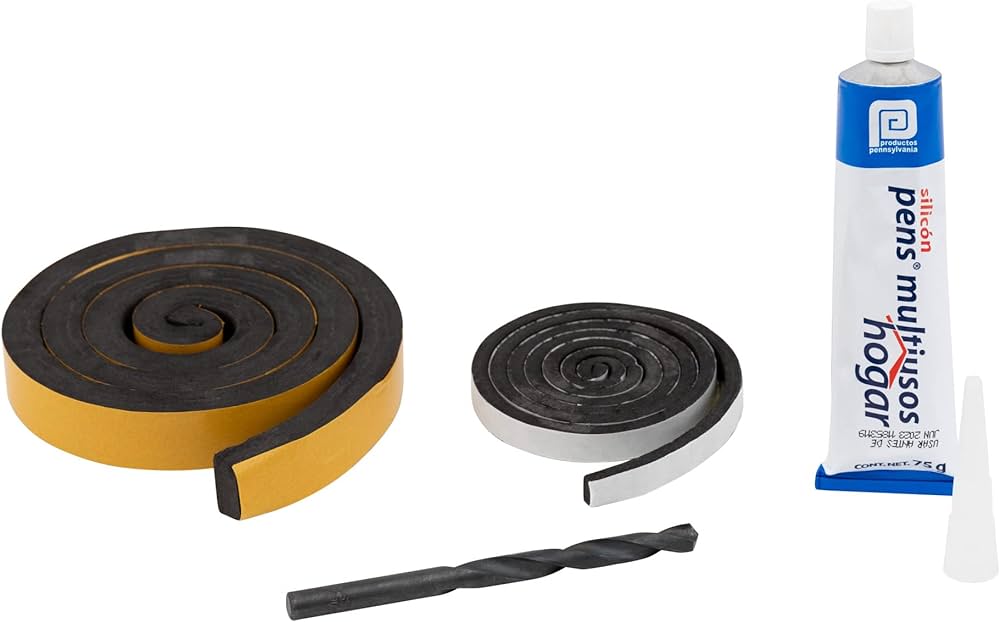
Why consider pet-safe materials and surfaces?
Creating a home where both you and your pets can live comfortably entails more than just providing spaces for play.
It’s equally important to consider the materials and surfaces used in your home.
What are the risks of common household cleaning products?
Many commonly used cleaning products contain toxic chemicals. For example, ammonia, often found in multitask cleaners, poses a risk to pets.
Bleach, chlorine, or formaldehyde, present in many bathroom cleaners and disinfectants, can also be harmful.
Other hazardous components such as phenol and isopropyl alcohol are usually included in soaps or hand sanitizers.
What preventive measures can homeowners take?
You should keep cleaning products out of your pets’ reach. Never leave them unattended during cleaning.
Open windows or use fans for ventilation and consider using fragrance-free or odourless products.
Ensure all cleaned surfaces are completely dry before letting your pets back in the room.
What about switching to pet-safe cleaning products?
If possible, switching to pet-safe cleaning products can significantly reduce the risk of exposure to toxic chemicals for your furry family members.
The health of your pets is paramount. Choose cleaning products deliberately and foster a safer environment for them.
Creating Independent Living Spaces for Pets
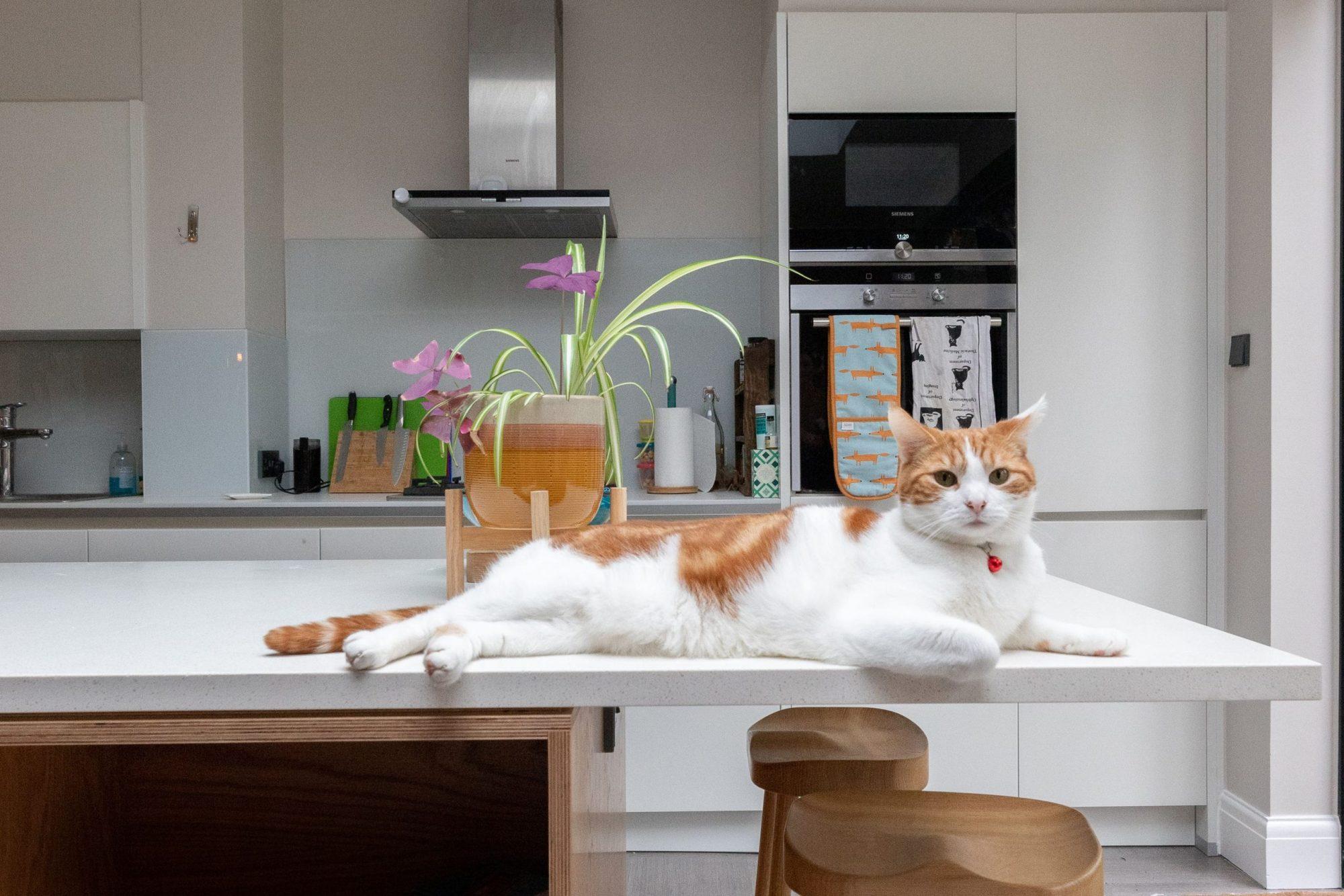
Our mates need their space too, not just us humans. Let me share some tips on how to create a comfortable and safe retreat for your furry friends.
Comfortable Kip Zones
Pick a warm, quiet area away from drafts and fit it with a quality, orthopedic bed. It’s top-notch for aging joints and muscles.
Slip-Proof Flooring
Avoid visits to the vet due to slips or falls. Use non-slip mats or carpets, especially in areas your pet often uses.
Adequate Lighting
The home should be well-illuminated, particularly in areas your pet frequents. Good lighting can help prevent accidents or missteps.
Raising food and water bowls to a comfy height can save your pet from straining their back or neck. Non-slip bowls are also a good shout.
Regular check-ups to the vet are essential for preventative care and routine examinations. It’s all about stopping problems before they start.
Exercise Areas
A safe place for short walks, stretching, and play is important. This not only keeps them fit but also keeps their minds sharp.
If your mate is experiencing discomfort, a chat with the vet about pain management or medication options is essential. Regular grooming is also important to maintain their coat and blood circulation.Nail trims and ear cleanings can also fend off discomfort and infections.
Now here’s the kicker – cognitive stimulation. Puzzle toys, interactive feeders, and gentle training sessions will keep your mate’s mind active. Also consider engaging with trained therapy animals for companionship.
Unique Amenities for a Dog-friendly Kitchen
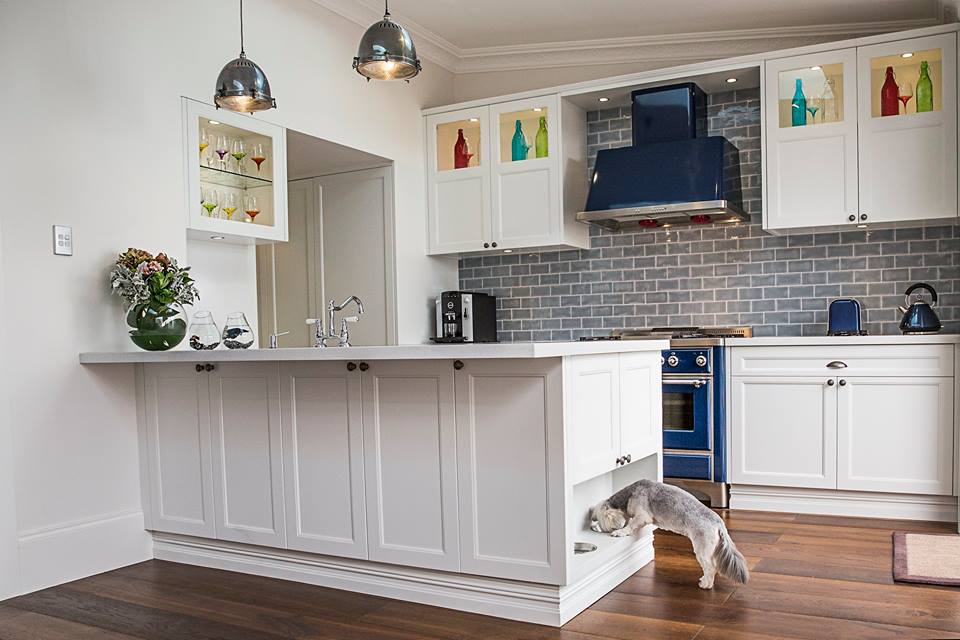
When considering a dog-friendly kitchen, flooring is crucial. Prioritise surfaces that are durable, easy to clean, and can cope with pet messes.
The ideal kitchen has cabinetry designed to outsmart curious pets. Protect your food and kitchenware by installing higher shelves or using child safety locks.
- Durable Flooring: Opt for tough materials like laminate or tile. They’re resilient against scratches and spills, making cleanups simpler.
- Secure Cabinetry: Choose designs that deter nosy fur friends. Cabinet doors that close automatically can prevent pets from helping themselves.
- Scratch-Resistant Countertops: Consider hard surfaces like quartz or granite. It’s important they’re not easily damaged by excited paws.
- Pet-Safe Appliances: Safety should always be the priority. Ensure appliances are not within reach of adventurous pets.
A pet-friendly kitchen also features easy-to-clean countertops. Look for something scratch-resistant to fend off any claw marks.
Ponder over your appliances: those that are safe for dogs are vital. Keep the stove and oven controls out of paw’s reach to prevent accidents.
The key is to create a space where you and your furry friend can enjoy without worry. After all, the kitchen is the heart of every home—pets included!
Challenges in Designing Pet-friendly Kitchens
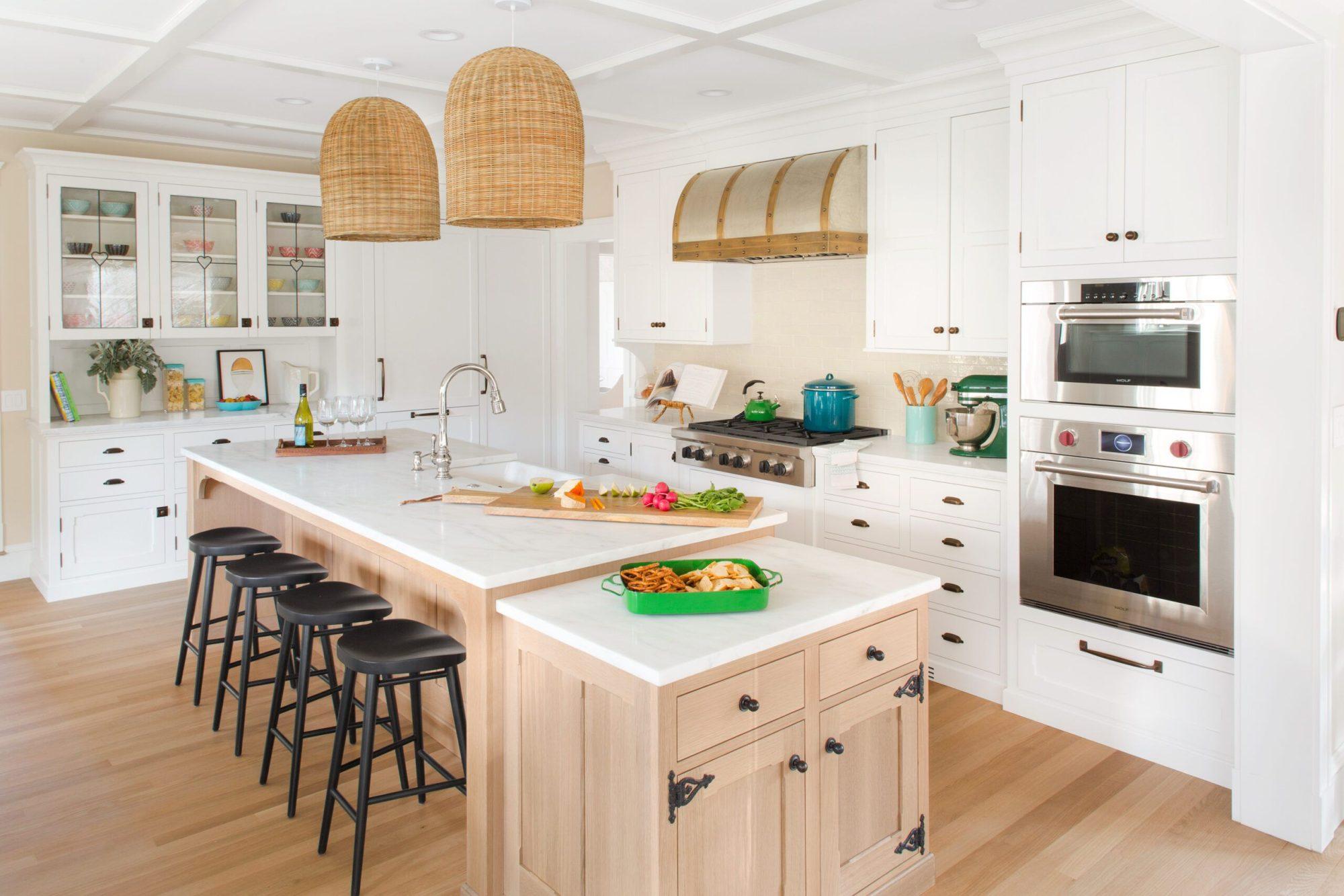
Creating a kitchen that’s friendly for pets can be a bit tricky. It requires considerations beyond the typical elements of functional design and aesthetics.
You’ll need to incorporate pet-friendly solutions such as integrating pet crates into your kitchen cabinets for easy accessibility and storage.
Thoughtful Designs for Cats
Careful design can accommodate your feline friends too. Toe-kick drawers provide an ideal hiding spot for food, and discreet litter box solutions can minimise unsightly mess.
Stylish yet practical pet feeding stations are another winning idea. Space-efficient solutions with bowls and pot fillers help keep things neat.
Canine-friendly Bathing Stations
Dogs also get a look-in with elevated platforms and convenient features in their bathing stations. These make bath time less messy.
Additionally, you might consider utilising laundry rooms or mudrooms as places for pet feeding and litter areas, keeping the kitchen cleaner.
Do-it-Yourself Kitchen Solutions
Pet beds could be integrated into cabinetry for seamless integration, making your beloved pets feel part of the family space.
Installing hidden pet food storage in existing spaces is another easy win, as opting for durable flooring solutions like tile, luxury vinyl plank, cork, or bamboo.
Safe Zones and Pet-Proof Countertops
A safe kitchen for pets requires dedicated safe zones during cooking activities, preventing pets from accessing dangerous materials and tools.
Pet-proof countertops are crucial too. Prevent jumps onto them or simply use scratch-resistant surfaces to maintain your kitchen’s integrity.
Rugs and Hardware Selection
Rugs are another consideration. Not only do they add a splash of style to your kitchen, a mindful selection of rugs can provide comfort for your pets too.
For hardware, knobs rather than pulls can prevent paw entrapment, while smooth, rounded surfaces are safer for curious explorers.</p
Pet-friendly Design: Balancing Function and Aesthetics
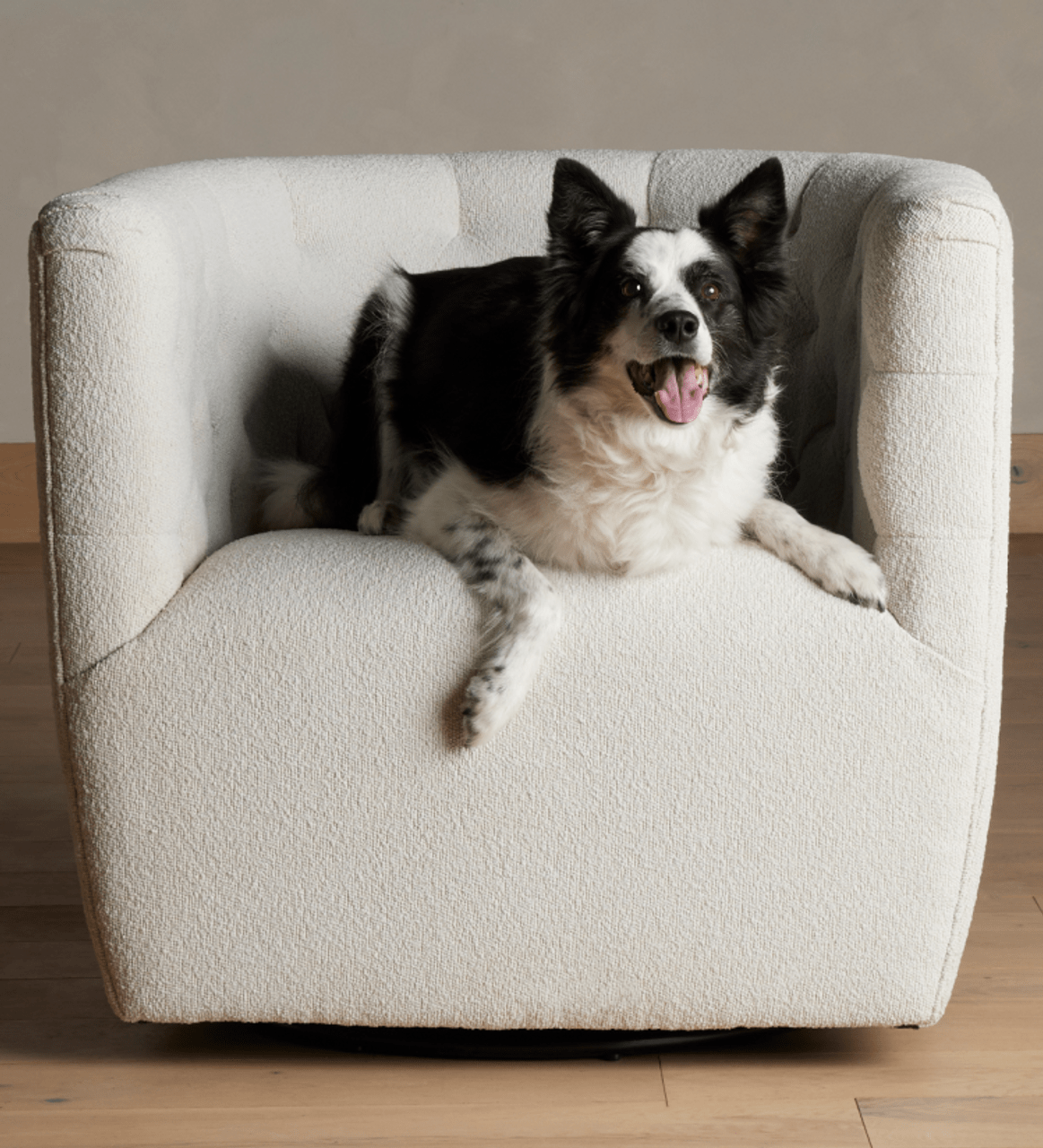
Our pets are part of the family. The trick lies in designing home interiors that satisfy both human aesthetics and pet requirements.
Innovative design concepts are making it possible to develop homes that are stylish yet pet-friendly, ensuring both owners and pets are content.
Functionality plays a crucial role in this. Choosing appropriate fabrics, materials, and furniture can create spaces that not only look good but can withstand whatever your pet dishes out.
The trend towards multi-functional furniture, such as side tables that double as litter boxes or pet beds, offers an aesthetically pleasing solution while meeting the practical needs of pets.
| Functional Pieces | Pet-Friendly Material | Aesthetic Appeal |
|---|---|---|
| Side table litter box | Durable wood | Modern styling |
| Cat tree | Non-toxic sisal rope | Natural look |
| Dog bed sofa | Tough fabric | Vintage charm |
| Pet feeding station | Stainless steel | Clean lines |
| Bird cage stand | Metal frame with wooden perch | Rustic elegance |
| Balancing functional needs with aesthetic appeal for pet-friendly designs. | ||
This balance of function and aesthetics can help create an environment that promotes the physical and mental well-being of your pets.
The use of tech is also impacting pet-friendly design. Smart pet-friendly solutions, such as automated feeders or remote-controlled toys, can enhance the comfort and safety of pets while also blending into the home’s décor.
It’s vital to pay attention to the small details in a pet-friendly design. Color schemes, furniture types, and accessibility all harmonize to make an enchanting space for your pet.
Lastly, don’t forget the importance of consulting professionals to help. Using their experience and expertise can take your pet-friendly design to the next level.
Case Studies of Successful Pet-friendly Kitchens
The beauty of a pet-friendly kitchen boils down to functionality and innovation. Take the clever pull-out pet drawer for instance. It’s perfect for all those fur babies who chow down with little mess.
But let’s face it, not every pet eats neatly. For the messy munchers, a waterproof drawer mat is a winner. It keeps dribbles contained and your kitchen spotless.
Making Mealtime Safer
Interior designer Gail Monica Dent is a fan of creating safe, out-of-traffic feeding stations. This way, your pets can feast without causing any tripping hazards or splashes.
Cat-specific Feeding Stations
Robin Rigby Fisher, another distinguished designer, has an ingenious solution for kitty mealtime woes. Her answer – a floorless corner cabinet with easy-to-clean flooring.
Water Stations and Stylish Gates
For pet-loving homeowners, innovative water stations are becoming popular. Fisher once devised a tastefully concealed gate to segregate pets during mealtimes without hindering daily foot traffic.
Clutter-busting Storage Solutions
Modern kitchens have various storage systems designed to keep pet items organised. These include bin storage for food and cabinet dividers to arrange your furry friend’s necessities neatly.
Innovative Resting Spots
Designer Richard Landon ingeniously repurposes underused spaces into quiet niches for pets. These can be under-the-sink cabinets, cubbies beneath islands or window nooks.
However, if you’re looking at an under-sink area, remember pets have sensitive ears, so you might need a sound dampening kit for peace and quiet.
Final Thoughts
Designing a pet-friendly Aussie kitchen is about more than just incorporating pet bowls and beds. It’s about creating a space that’s safe, accessible and enjoyable for your furry mates, considering aspects like materials, layout, and storage. With a bit of thought and planning, you can create the perfect kitchen that caters for every member of your family.
- Kitchen Oasis. Fusion of Relaxation and Functionality (AU) - November 2, 2024
- Pure Water Pleasure. Why You Should Consider Installing a Kitchen Water Filter - October 22, 2024
- Green Plumbing Practices. Eco-Friendly Ideas for Your Melbourne Kitchen - October 2, 2024
Related posts:
 Designing a Kitchen for Multigenerational Living (AU Homes)
Designing a Kitchen for Multigenerational Living (AU Homes)
 Creating a Sustainable Kitchen – Eco-Friendly Design Ideas for Australia
Creating a Sustainable Kitchen – Eco-Friendly Design Ideas for Australia
 Coastal Kitchen Chic. Designing for Sydney Beach Living
Coastal Kitchen Chic. Designing for Sydney Beach Living
 Designing a Kitchen for the Entertainer. Practical Tips for Sydney Homes
Designing a Kitchen for the Entertainer. Practical Tips for Sydney Homes
 Alfresco Entertaining: The Ultimate Aussie Outdoor Kitchen
Alfresco Entertaining: The Ultimate Aussie Outdoor Kitchen
 Family Central: Aussie Kitchen Design for Busy Lives
Family Central: Aussie Kitchen Design for Busy Lives



